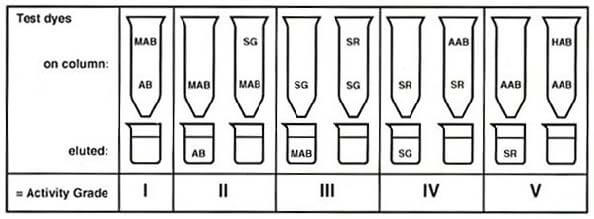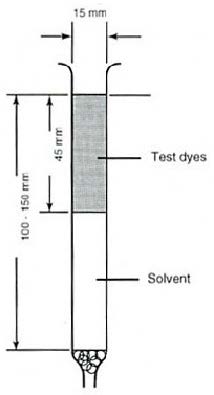Determination of Activity using the Brockmann and Schodder Test
The Brockmann and Schodder test is a simple and reliable method to determine the activity of adsorbents. A standardized volume of pairs of test dyes dissolved in a standard solvent is applied to a standardized column. After chromatographic development, the activity is shown by the way the test dyes are separated or not separated.
The following dye mixtures are used:
- I Azobenzene (AB) and p-Methoxyazobenzene (MAB)
- II p-Methoxyazobenzene (MAB) and Sudan yellow (SG)
- III Sudan yellow (SG) and Sudan red (SR)
- IV Sudan red (SR) and p-Aminoazobenzene (AAB)
- V p-Aminoazobenzene (AAB) and p-Hydroxyazobenzene (HAB)

20 mg of each of the two dyes of an individual pair is weighed into 50 ml of the solvent.
A mixture of one part of pure benzene and four parts of pure petroleum ether (bp 50 – 70°C) (v/v) is used as solvent for the test dyes and as eluent for the chromatographic development.
10 ml of the appropriate test dye solution is carefully applied to the top of a 15 mm diameter column, filled to exactly 50 mm in height with the adsorbent to be tested. Then the column will be eluted with 20 ml of the eluent. The activity grades can be determined according to the diagram.
It has been suggested that a modification to the Brockmann and Schodder method be made in that using columns of 100 – 150 mm length be used instead of exactly 50 mm high adsorbent beds. On these columns no elution occurs. To determine the activity grade, the migration distance of the test dye in front is measured. The activity grade is then given by the number of the pair of test dyes. In addition with the distance, in mm from top of the column to the front of the foremost migrated dye.
In the example, test dye solution #I is used and azobenzene migrates 45 mm. The activity grade of the adsorbent is I/45 mm.



